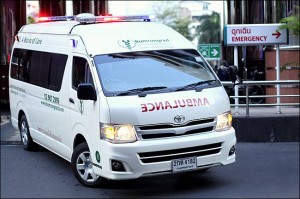The rise of medical tourism in Thailand has left the country’s health care system facing a critical test. As the government looks to attract ever higher numbers of overseas patients, there are concerns that access to health care for its own population of 67 million may suffer, admit Thai health officials.
In January, the Ministry of Public Health will launch its latest medical tourism strategy, a four-year plan to cement Thailand as the leading medical hub in Asia, with a target to make $6 billion per year by the end of 2017. But cracks are already starting to show in the other side of what the Thai government calls its “dual-track policy,” which aims to develop both the public and private health sector.
Although still little understood, there are mounting fears medical tourism may be fueling brain drain to the private sector, causing a lack of doctors and nurses in state hospitals and in turn widening Thailand’s health gap.
“Some [nongovernmental organizations] and reporters said that our policy impacts on Thai citizens accessing medical services, on the price and quality standards,” said Dr. Saowapa Jongkitipong, deputy director of the Department of Health Service Support, which created the new medical hub strategy.
The Ministry of Public Health has not ignored these criticisms, she said. The aim is to also train more doctors and nurses to meet public health care staffing shortages, according to the ministry’s new strategy, though details remain vague.
Furthermore, plans for a National Health Statute aimed at supporting nonprofit hospitals and primary care services with financial backing by the Thai Board of Investment have stalled, said Dr. Tipicha Posayanonda, a public health expert at the National Health Commission Office, which was charged with devising the plan.
Part of the problem was a change of government in 2011 amid a bitter political divide in the country. For more than two years, the draft plan has been held up and the Board of Investment’s board of directors has still not seen it, meaning there is no strategy in place to fix the deficiencies of Thailand’s health services in less developed areas of the country, said Posayanonda.
“We’re lacking some doctors so we need to get a balance,” she said. “We’re trying to help poorer people.”
As Thailand moves ahead with plans to further increase medical tourism, the effects of catering to the needs of hundreds of thousands of additional patients every year are only just being understood, say researchers and medical professionals.
Medical tourism adds an estimated 0.4% to Thailand’s economy every year, which raises income for the medical services sector, concluded Anchana NaRanong and Viroj NaRanong in their 2011 study of the impacts of the industry. Other positive effects include a higher standard of medical hardware courtesy of the best private hospitals. Overall, however, Thailand’s medical tourism drive is causing growing disparity when it comes to access to health care, the study concludes.
“Negative effects are evidenced by both a shortage of physicians and by increased medical fees for self-paying Thais, which are likely to undermine their access to quality medical services,” the paper added.
In other words, for Thais who can afford to pay for private health care, costs are being driven up by medical tourism. For those who rely on basic, government health schemes — more than 80% of the population — staffing levels in state hospitals are being undermined by private sector brain drain.
The number of Thai medical graduates was expected to climb from 1500 to 2300 after 2010, but the NaRanong study found that foreign patients take up more physician time, so the distribution of doctors in underprivileged, remote areas remains low.
In response, the Ministry of Public Health has recently required new and existing private hospitals to provide data on the number of current and intended employees so that manpower can be better planned.
As Thailand leads the way in the fast-growing medical tourism market, it could provide lessons for other developing countries, such as India and Mexico. But it is only just learning what those lessons might be, said Dr. Nima Asgari, public health administrator in the World Health Organization’s Thailand office.
Data at the local level on the burden of diseases and availability of services remain inadequate, said Asgari. “The impact of medical tourism on the public health sector is currently being investigated by the Ministry of Public Health but it is still too early to say anything definitively.”
Source: CMAJ


